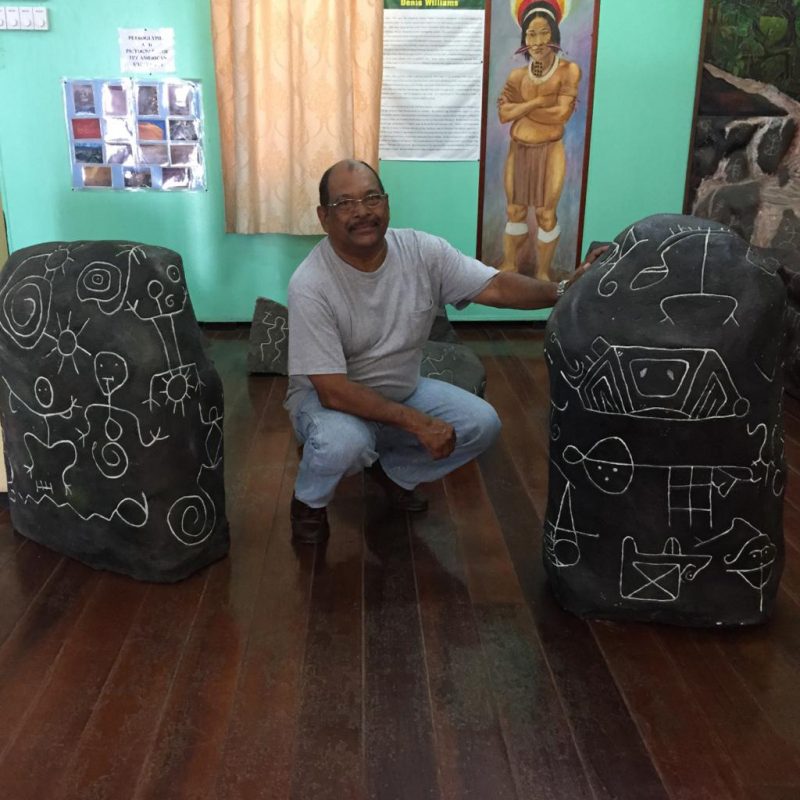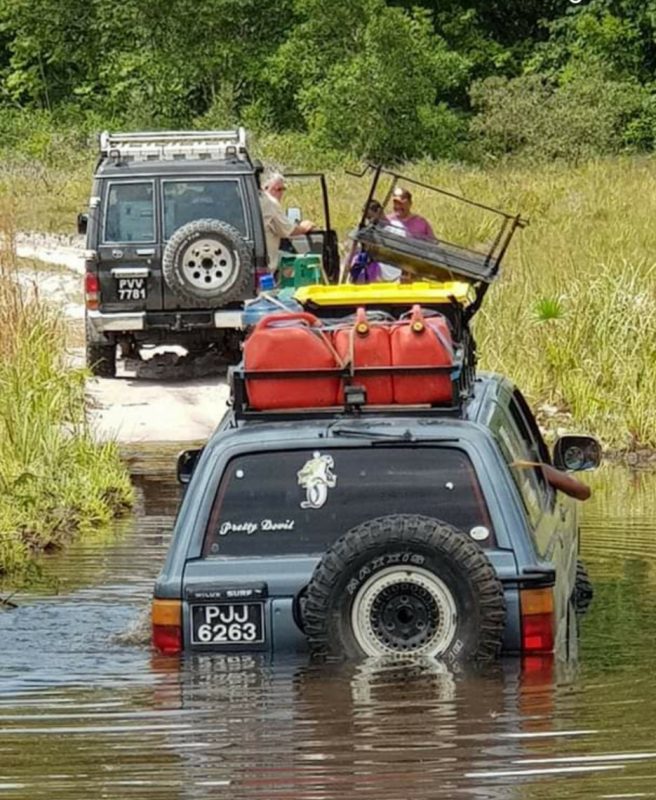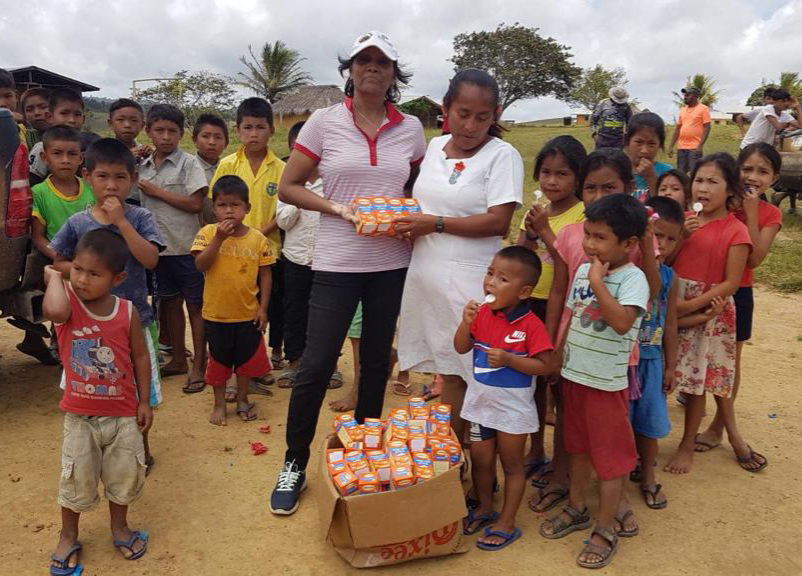In 1995, tour operator Frank Singh, 63, of Diamond, East Bank Demerara and his wife Sabita took a lead and started the adventure tour company, Rainforest Tours, when local tourism was virtually unheard of. They wanted to give up the company at times but persevered and today it is one of two local tour companies still operating in Guyana from the 1990s.
“We have been around for 27 years and Rainforest Tours is now internationally recognised as a tour company. We were one of the first local tour companies that started in this country.
The only three established companies in those days were Wonderland Tours, Rainforest Tours and Wilderness Explorers. Only Rainforest Tours and Wilderness Explorers are still operational.”
He continued, “Today, we are a niche for any adventure tours and we are a logistic support company for filming companies visiting Guyana.”
“We have worked with National Geographic, BBC World and Discovery Channel, among others, doing adventure, environmental films and documentaries in Guyana.”
Singh told Stabroek Weekend when he and Sabita started the company they offered city tours to overseas visitors, Essequibo/Mazaruni river tours, a Kaieteur/Orinduik falls air tour and a tour to Santa Mission on the Kamuni Creek, Demerara River.
“We then had requests for adventure tours. We pioneered the Kaieteur overland tour. We put down an infrastructure at Amatuk and we worked along with Kaieteur National Park. The park extends to Waratuk and goes all the way back to Tukeit.”
The Singhs started Rainforest Tours from their then home in Barrack Street, Kingston. In 1997 Singh negotiated with Richard Humphrey, then owner of Hotel Tower, for a space under the step in the hotel’s lobby where they were until 2000 when the hotel was sold. After that they moved to Avenue of the Republic where they stayed until the Covid-19 outbreak. “Right now we are working out of Lot 18 Craig Street, Campbellville.”
Born and bred in the heart of Georgetown, Singh grew up in Regent Street. He attended Central High School. His father owned an electronics store so he went to the Government Technical Institute to become an electronic technician after high school. However, with a penchant for adventure, he went to work in the interior with a gold and diamond mining company, which took him to Venezuela where he lived for over a decade. The father of four children, his last daughter was born in Venezuela.
In Bolivar, Venezuela, he gained some knowledge about the tourism industry and fell in love with it. In Bolivar he lived in an apartment that was next door to a Venezuelan tour operator. “I used to lime with the operator on a weekend and he showed me around. By then I conversed in Spanish and he used me as an interpreter when he had English-speaking visitors. That is where my interest in tourism began. I was about 27 years at the time. Later on the mining company I worked with was affected by the construction of the Macagua hydro dam in Ciudad Guayana. After they built the dam, no dredging could take place because of the depth of the waters, so they closed their operations and I came back home wanting to develop my tourism ideas.”
In 1994 Singh did a lot of footwork in trying to develop his ideas and in 1995 registered Rainforest Tours.
“In 1995 Guyanese hardly knew anything about tourism. Richard Ousman of Wonderland Tours was the only local tour operator. We worked together. It wasn’t an easy task. We walked from hotel to hotel or bar to bar to sell our companies and our tours. We had television but no marketing strategy.”
Today Rainforest Tours has a regular client base, promotes its products through digital marketing and by word-of-mouth exposure through regular customers who may invite their friends to take part.
When he returned to Guyana he had to reacquaint himself with the country. “I talked and learned from Richard Ousman and other people. I took advantage of a tour guide training programme the Caribbean Tourism Organisation held in Guyana. I worked with World Wildlife Fund in logistics and they had a tour guide instructor who trained me in tour guiding and tourism management.”
Later on Singh became a tour guide instructor and assisted in training in the “first ever locally-sponsored tour guide training programme,” held at the then Emerald Towers on the Linden- Soesdyke Highway.
Challenges, safaris
At Hotel Tower guests started booking tours. “At that time, too, it wasn’t easy because aircrafts were limited. Most of the aircrafts dealt with domestic flights to villages and to mining areas. Sometime we’d book a flight and the air carrier would cancel the flight to meet other request they considered more important. There were many times we had to cancel flights to Kaieteur.”
At that time too, he said, there were no rules and regulations governing tourism. The ministry of tourism was feeling its way. Then the Guyana Tourism Authority started introducing rules and regulations and regularizing tourism.
“In those days we were doing and learning things through trial and error. We expanded the company when we started the overland tours to Kaieteur.
A gentleman called Zigman from Whitehole in the Mahdia, Potaro area and I recced the overland route. We employed more people from Chenapau and other villages including Waramadong. All the tour guides I employed and trained were from Amerindian communities.”
He continued, “I started the Kaieteur Overland Tour, the Kaieteur to Orinduik Falls Tour in which we fly to Kaieteur, boat to Chenapau and hike to Orinduik and then fly back to the city from Orinduik. We were the first to hike from Bartica through Issano trail to Marshall Falls where we take a boat and return to Bartica by river.”
Then 14 years ago, then prime minister, Samuel Hinds invited Singh to take part in a safari and to make a tourism product out of it. ‘Safari’ is the Swahili word for a long journey. The safaris start from Georgetown.
“We called the first safari, the Pakaraima Mountain Safari. We did another to Orinduik for a few years and then expanded it to other areas. From Georgetown to Mahdia and then onto Bartica and from Georgetown to Moraikobai Village.”
At present Rainforest Tours is doing a five-day South Rupununi Safari in which a convoy of 17 vehicles is driving all the way to Aishalton. It began on November 24. “We are coming out of a pandemic and things are not as stable as pre Covid-19, so I don’t want to take a large convoy and then cause an outbreak.”
Depending on the safari it could take from three days as in Georgetown to Moraikobai or to seven days as from Georgetown to Orinduik.
He noted the safaris actually started as an outreach programme led by then regional chairman and the regional executive officer (REO) of Region Eight(Potaro/Siparuni) with then minister of local government and regional development Harripersaud Nokta.
“It started with a tractor and trailer and one pick up to see how they could help the people in Regions Eight and Nine by making the roads more accessible to trucks and four-wheel drive vehicles to take in much needed food, medical and other supplies. They then invited Prime Minister Hinds to take part and he invited me to go along with him to convert the trip to a tourism product.”
The safari is now an established tourism product. To date over 300 vehicles have taken part in the safaris over the years.
“The largest convoy we had was with 30 vehicles. Today participants from Jamaica, Canada, Suriname, Barbados, Brazil, Trinidad and Tobago, [and] Belize, among other countries, take part in the safaris.”
Some participants ship their vehicles and motor cycles while others rent local vehicles to take part in the adventure or join trucks that Rainforest Tours provide.
“The safaris have international recognition because of their participants. At the same time, we team up with some motor cycle clubs like Sonic Motor Cycle Club and Lethem’s Rupununi Trails. The biggest safari of all is the North Pakaraimas Safari that goes to Orinduik. It is the most challenging of the safaris.”
The safaris are a collaborative effort in which the Ministry of Amerindian Affairs, REOs, neighbourhood democratic councils, villages and police outposts play a role. Iwokrama River Lodge is also informed about the journey should the safari require help, including medical assistance.
In the safaris, Singh said, villagers welcome them. “We are happy to see them. We send them our itinerary and ask them to bring out whatever produce they have in the villages to market. On that market day we buy all their produce. That is compulsory for all the participants taking part.”
He said it is compulsory all participants contribute to a village or all the villages they go through. In the past they donated cloth to sewing clubs, and stationery to schools.
“Seeing this safari is closer to Christmas, the emphasis has been on toys for the children and other Christmas goodies. We have people in the USA and Canada who send clothing which we put in bags and distribute to the villages we pass through. We do other things. We are going through Dadanawa and Shea Village in this safari. At the same time, we pay a village fee.”
In the early days, Singh noted the Ministry of Health and the Forestry Commission sent representatives in the convoy to do outreaches. “Not now. Now the safaris are more adventure-tourism oriented. We just do our thing as a tourist package.”
Adventure tourism is not only hype and toughing it out. He said, “It is an outdoor school and very educational. It teaches people about your culture, cuisine, customs, the beauty in the topography and climate of the country, its biodiversity, and the country in general. You learn from an area and because of our diversity Guyana has much to teach in terms of the Amerindian, East Indian, African, Portuguese, Chinese and other cultures. When you explain the cultures to visitors they become very interested.”
He noted a lot of people come to Guyana because of the preservation of our rainforests. “Guyana is 83,000 square miles of which over 87 per cent is either primary or secondary forests. People want to see the harpy eagle, largest bird of prey in South America, the arapaima, which is the world’s largest fresh water fish and so many others animal species we have in Guyana. Guyana is also becoming a well-known birding destination.”
Based on his years of experience in the industry, Singh has served as a member of the board of directors of the Kaieteur National Park and the Guyana Tourism Authority. He was also elected a vice president of the Tourism and Hospitality Association of Guyana.
He has helped to promote Guyana’s tourism at several Caribbean and international travel fairs and trade shows, including in Holland, Germany, England in Europe and in North America.
Wanting to give up
“Many times I questioned myself about why it was I was working so hard and I wanted to give up. The returns were very slow. But as husband and wife, Sabita and I always talk and motivate each other. That kept us going. There were times we were working day and night and not seeing an income. Things gradually started to get better with rules and regulations being put in place and governments taking an active role in the development of the tourism industry.”
There were times, he said, it crossed his mind to migrate but then he thought about missing the rainforests. “You could take the man out of the bush but you can’t take the bush out of the man. Most of my life I spent in the bush. I got to have that green, fresh smell, the oxygen you know.
It is relaxing. It is a stress-free environment and I like being my own boss.”
Reflecting, he said, “My patience has paid off. In business you have to go for the long run to get long terms results. The sacrifices were worth the while. It is not 100 per cent there but we are going in the right direction. In the next 10 to 15 years Guyana is going to be one of the top countries for eco, nature and adventure tourism. We have what people want to see. People are more conservation-oriented right now. The next generation will benefit. They are getting it easier.”
While Singh was focused on educating his children to become professionals none has taken up his business. However, he said he has grandchildren who are interested in the company so he does not think his efforts will go in vain. “My grandchildren are showing an interest in the company. One of my grandsons who goes with me on some of our tours is paying a keen interest in running the company in time to come.”







